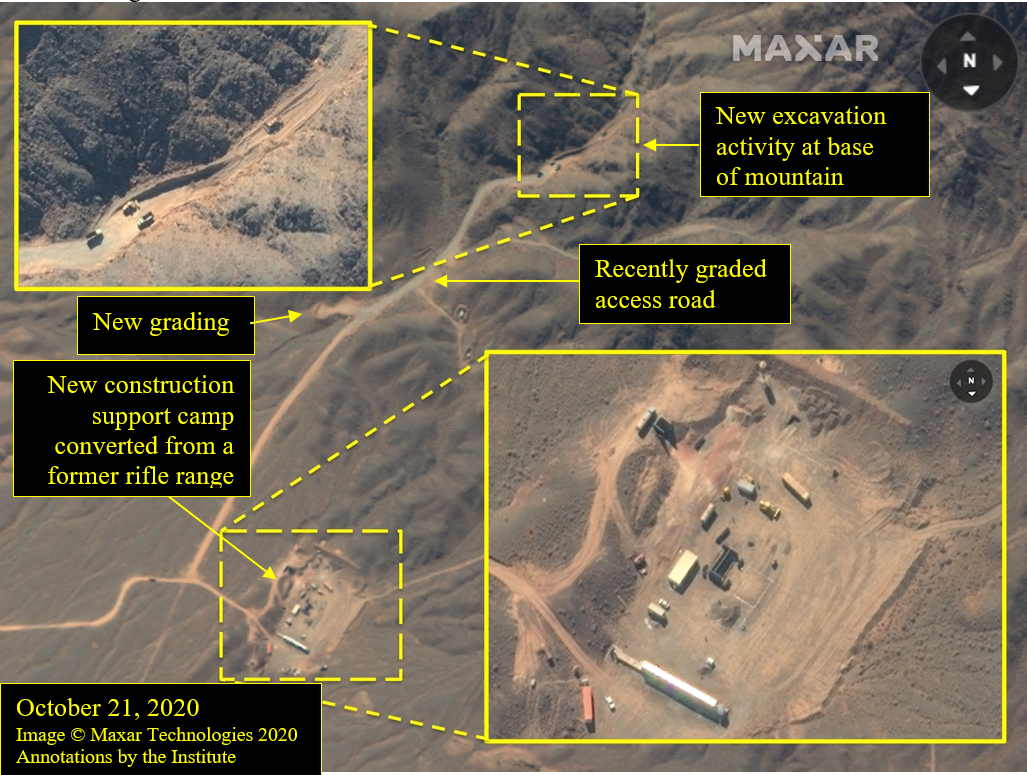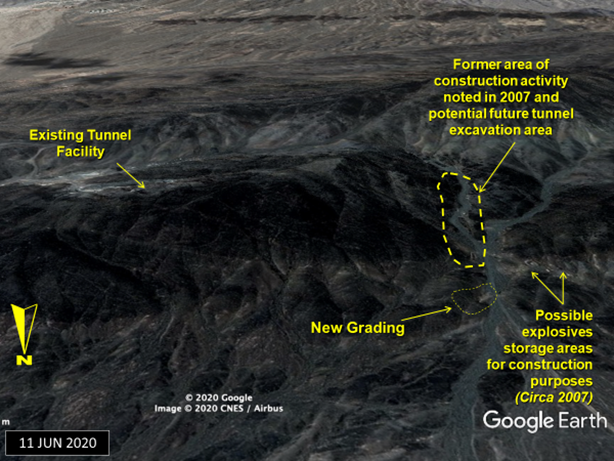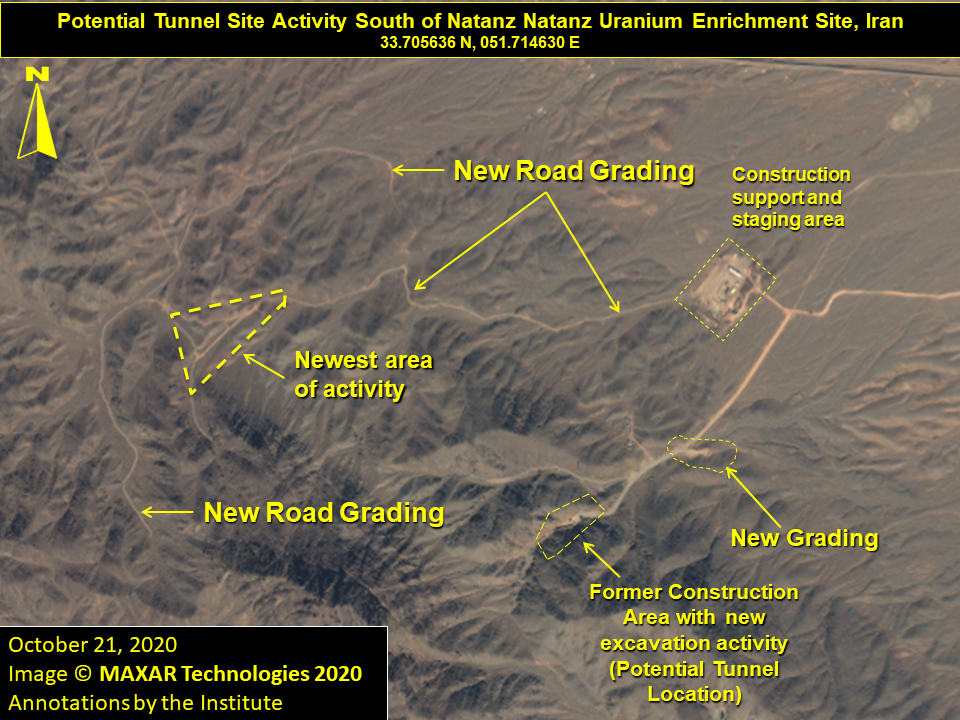Update on New Construction Activity at Natanz
This report is an update to an October 7, 2020 report1 on Iran’s construction of a new centrifuge assembly facility in the mountains near the Natanz enrichment plant. Newly obtained high resolution commercial satellite imagery shows:
- Continued work at what we had identified in the October 7th report as a former gunnery range being converted into a construction staging area: additional clearance; addition of permanent structures to the previously identified construction sheds; and additional construction equipment;
- These recent changes indicate the staging area could be a future location of support buildings for the reported future underground centrifuge assembly center, such as administration and security support facilities;
- There are no indications that the staging area will be the location of a bunkered centrifuge assembly facility;
- More indicative of the future centrifuge assembly location is the visible preliminary excavation along the newly graded road at the base of the nearby mountain, which could be for a planned tunnel entrance;
- There is additional new road grading connecting the staging area to the nearby mountains in a new area west of the staging area (previously not present or reported)
- No new visible activity at the nearby pre-existing tunnel entrances built in 2007, but the grading and preliminary excavation described above is underway on the opposite side of the same mountain.
In early September 2020, Iran announced its earlier decision to replace its Iran Centrifuge Assembly Center (ICAC), destroyed in early July of this year,2 with a new facility in a mountain near the Natanz uranium enrichment site. According to Ali Akbar Salehi, head of the Atomic Energy Organization of Iran (AEOI); “It was decided to establish a more modern, wider and more comprehensive hall in all dimensions in the heart of the mountain near Natanz. Of course, the work has begun.”3 The destroyed site was designed to assemble thousands of advanced centrifuges each year. Its destruction set back Iran’s plans to expand its centrifuge program by at least a year and perhaps longer. Exactly how long will depend on Iran’s ability to rebuild the new facility, outfit it with sensitive equipment, and bring it into operation. Our October 7th report concluded that completion would likely not occur in 2021. In an interview with the Associated Press, International Atomic Energy Agency (IAEA) Director General Rafael Grossi stated, “They have started, but it is not completed…It’s a long process.”4 Together with the recent imagery, this further supports our conclusion.
In our October 7th report, we noted significant changes at the former gunnery (rifle) range, rendering the range useless for its original purpose and indicating the creation of a construction support and staging area. Construction sheds and bulldozers parked on the range were already visible. The recent imagery supports that initial assessment, including the additional clearance of the area, additional construction equipment and machinery, the heavy use of recently graded road, and the addition of a newly graded road network that connects the staging area with a new area of activity in the mountains 2.5 kilometers to the west.
In addition to construction support, this area contains what may end up being more permanent buildings. Figure 1, an October 21, 2020, Maxar Technologies image shows walls for one structure partially erected and another structure outlined on the ground. Such buildings at this location or nearby would not be surprising, given that Iran will need a place to organize the engineering and personnel and equipment going into an underground site during its construction and thereafter for administration and site security when underground operations commence.
Figure 1. A close-up of the construction staging area and possible future support area for the underground centrifuge assembly.
While there is the possibility to bunker the place similar to the Natanz underground enrichment halls, there are no indications of trenches or holes being excavated to suggest any basements. Moreover, for perspective, the Natanz underground enrichment halls were not built in a depression or a graded area, but in massive 23 meters deep excavations. By contrast, the visible buildings in this area are being built directly at existing grade surface level, relatively central to the cleared area of the former gunnery (rifle) range, in a space which would be assumed used more efficiently if it were to also host a larger, bunkered centrifuge assembly facility. Lastly, while Iranian statements are often misleading, one cannot consider this specific location to be the “heart” of any mountain. Our overall conclusion at this juncture is that this area is most likely serving as a construction support and staging area that will eventually host administration and engineering offices, and possibly serve as a security access control area.
The initial excavation that has begun on the base of the nearby mountain is more indicative of, and consistent with, a future underground location. Figure 2 shows the area of excavation in relation to the identified staging area and the newly graded road connecting the two. Bulldozers and dump trucks can be seen active in the area on this October 21, 2020, high- resolution image.
Interestingly, the mountain that harbors the existing tunnel site built in 2007 is the same mountain where we are now seeing what appears to be preliminary excavation activity. There is also new grading visible at the base of the mountain roughly 200 meters north of the excavation. Figure 3 is a Google Earth image that gives a perspective view and shows the relative positions of the existing tunnel facility, the new excavation, and the new grading.
Figure 2. Overview of the monitored area, where activity is consistent with a future tunnel at the base of the mountain and an above-ground support area nearby.
Figure 3. This Google Earth perspective view reveals that the location of the excavation along the newly graded road and the new grading off the same road are at the base of the same mountain that harbors the existing tunnel facility constructed in 2007.
Further examining the area south of the Natanz uranium enrichment plant reveals that an additional graded road network is now visible in the mountains west of the construction support and staging area. It is unclear at this time what might be under development there, but medium-resolution Planet Labs imagery from October 26, 2020, available as part of a time-lapse video published on Twitter,5 shows that this newest area of activity has been further developed in the past days. Figure 4 provides an overview.
Figure 4. Additional road grading to a new area of activity is newly visible approximately 2.5 kilometers west of the construction support and staging area in mountainous terrain.
Conclusion
The on-going construction-related activity that we have observed through late October 2020 continues to be consistent with Iranian statements about its effort to build expeditiously a new centrifuge assembly plant in the mountainous area near the Natanz uranium enrichment plant.
Although the location of the new centrifuge assembly facility is still not fully clear, the new excavation activity along the newly graded road at least suggests that preparations are underway for it to be most likely constructed in a tunnel in a mountain near the old rifle range. This general area also includes pre-existing tunnels (dating to 2007) that have already been associated with the Natanz enrichment plant, and Iran may be planning to build additional facilities underground, with new support areas located nearby on the surface.
Although this new construction activity appears to be progressing quickly, the completion of any underground facilities can be expected to stretch out over the next few years.
Sources
1. David Albright, Sarah Burkhard, and Frank Pabian, “Looking for Evidence of the Construction of Iran’s New Centrifuge Assembly Plant: New Possible Preparations Identified,” Institute for Science and International Security, October 7, 2020, https://isis-online.org/isis-reports/detail/looking-for-evidence-of-the-construction-of-irans-new-centrifuge-assembly ↩2. David Albright, Sarah Burkhard, and Frank Pabian, “Update on Assessing the Detonation at the Natanz Iran Centrifuge Assembly Center: New High Resolution Satellite Imagery Refines Details on the Explosion and Fire,” Institute for Science and International Security, July 9, 2020, https://isis-online.org/isis-reports/detail/update-on-assessing-the-detonation-at-the-natanz-iran-centrifuge-assembly ↩
3. Parisa Hafezi, “Iran building new production hall for centrifuges in mountains near Natanz,” Reuters, September 8, 2020, https://www.reuters.com/article/iran-nuclear-natanz/iran-building-new-production-hall-for-centrifuges-in-mountains-near-natanz-idUKL8N2G540Z ↩
4. David Rising, “UN watchdog: Iran building an underground nuclear facility,” Associated Press, October 27, 2020, https://www.rferl.org/a/un-watchdog-confirms-new-construction-at-iran-s-natanz-nuclear-facility/30916769.html ↩
5.https://twitter.com/ArmsControlWonk/status/1321250421315309569?s=20 ↩



